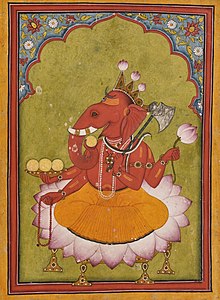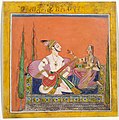Basohli | |
|---|---|
Town | |
| Coordinates: 32°30′N 75°49′E / 32.50°N 75.82°E | |
| Country | |
| Union Territory | Jammu and Kashmir |
| District | Kathua |
| Elevation | 1,200 m (3,900 ft) |
| Population (2011) | |
| • Total | 5,433 |
| Languages | |
| • Official | Dogri, Pahari, Hindi, English |
| Time zone | UTC+5:30 (IST) |

Basohli (formerly Vishwasthali) is a town near Kathua in Kathua district in the union territory of Jammu and Kashmir, India. It is situated on the right bank of River Ravi at an altitude of 1876 ft. It was founded by Raja Bhupat Pal sometime in 1635. It was known for the palaces which are now in ruins and miniatures paintings (Basohli school of Pahari painting). The Battle of Basoli was fought in this region.
Basohli is known for its unique 'Basohli Paintings'. In the late 17th century, Basohli emerged as a great centre of painting. According to well known Dr. Herman Goltz, "Basohli painting are among the great achievements of Indians". Their central inspiration is Vashnavism, the themes have been taken from the Epics and the Puranas.
The different themes of the paintings are religious (Gita Govinda and Ramayana), secular, historical, contemporary and literary. Besides the paintings bring out extreme emotion combined with a lyrical sense of Basohli landscape.
Basohli paintings are said to have been described as 'Poems in colours'. The paintings are marked by strikingly blazing colours bold lines, rich symbols and peculiar features giving an accumulative impact of highly sensuous environs.
Geography[edit]
Basohli is located at 32°30′N 75°49′E / 32.50°N 75.82°E.[2] It has an average elevation of 460 metres (1509 feet). Basohli is situated in the uneven lofty hills of Shiwaliks. It is situated in the right bank of Ravi river. Basohli's Thein dam has made it almost landlocked.
Demographics[edit]
According to 2011 census,[3] Basohli had a population of 5433. Males constituted 52.01% of the population and females 47.99%. Basohli had an average literacy rate of 77%, higher than the national average of 59.5%; with 57% of the males and 43% of females literate. 12% of the population was under 6 years of age.
Religion[edit]
The religious distribution of the population is as follows - Hindu 83.01%, Muslim 16.38%, other 0.61%.[4]
Basohli painting[edit]
Basohli is widely known for its paintings, which are considered the first school of Pahari paintings, and which evolved into the much prolific Kangra paintings school by mid-eighteenth century.[5] The painter Nainsukh ended his career in Basohli.
-
Goddess Bhadrakali, adored by the Gods. Basohli. India. c. 1660–70.

Basohli painting has obtained Geographical Indication (GI) Tag in March, 2023.Basohli painting was a vigorous, bold and imaginative artistic style, rich, stylish and unconventional. A style of painting characterized by vigorous use of primary colours and a peculiar facial formula prevailed in the seventeenth and early eighteenth centuries in the foothills of the Western Himalayas in the Jammu and Punjab States. The earliest paintings in this style have been dated to the time of Raja Kirpal Pal (1678–93).[6]
Originating in Basohli State, the style spread to the Hill States of Mankot, Nurpur, Kulu, Mandi, Suket, Bilaspur, Nalagarh, Chamba, Guler and Kangra. The first mention of Basohli painting is in the annual report of the Archaeological Survey of India for the year published in 1921. Referring to the acquisitions of the Archaeological Section of the Central Museum, Lahore, the report states that "a series of old paintings of the Basohli School were purchased, and the Curator concludes that the Basohli Schools is possibly of pre-Moghul origin, and so called Tibeti pictures are nothing but late productions of this school".
History[edit]
The Battle of Basoli was fought in Basohli between the Sikhs and the Mughal Empire aided by the Rajputs of the hill states in 1702.
See also[edit]
References[edit]
- ^ National Museum, New Delhi. For description of the work see: Martin-Dubost (1997), p. 73, which says: "Ganesha getting ready to throw his lotus. Basohli miniature, circa 1730. National Museum, New Delhi. Attired in an orange dhoti, his body is enitirely red. On the three points of his tiny crown, budding lotuses have been fixed. Gaṇeśa holds in his two right hands the rosary and a cup filled with three modakas (a fourth substituted by the curving trunk is just about to be tasted). In his two left hands, Gaṇeśa holds a large lotus above and an axe below, with its handle leaning against his shoulder. In the Mudgalapurāṇa (VII, 70), in order to kill the demon of egotism (Mamāsura) who had attacked him, Gaṇeśa Vighnarāja throws his lotus at him. Unable to bear the fragrance of the divine flower, the demon surrenders to Gaṇeśa."
- ^ "Basholi". Falling Rain.
- ^ "Census of India 2001: Data from the 2001 Census, including cities, villages and towns (Provisional)". Census Commission of India. Archived from the original on 16 June 2004. Retrieved 1 November 2008.
- ^ "Bashohli Town Population Census 2011 - 2024". census2011.co.in. Retrieved 29 February 2024.
- ^ Chaitanya, Krishna (1987). "Pahari centres". Arts of India: Architecture, Sculpture, Painting, Music, Dance and Handicraft. Abhinav Publications. p. 62. ISBN 81-7017-209-8.
- ^ Singh, Chandramani (1974). "A Review of Basohli Style in Indian Painting" (PDF). Kailash - Journal of Himalayan Studies. 2 (1&2): 133–147. Archived from the original (PDF) on 6 September 2006.
Further reading[edit]
- Hutchinson, J. & J. PH Vogel (1933). History of the Panjab Hill States, Vol. I. 1st edition: Govt. Printing, Pujab, Lahore, 1933. Reprint 2000. Department of Language and Culture, Himachal Pradesh. Chapter XVIII Basohli State, pp. 587–613.
- Kossak, Steven (1997). Indian court painting, 16th-19th century. New York: The Metropolitan Museum of Art. ISBN 0870997831. (see index: p. 148-152, for information about Basholi painting)





